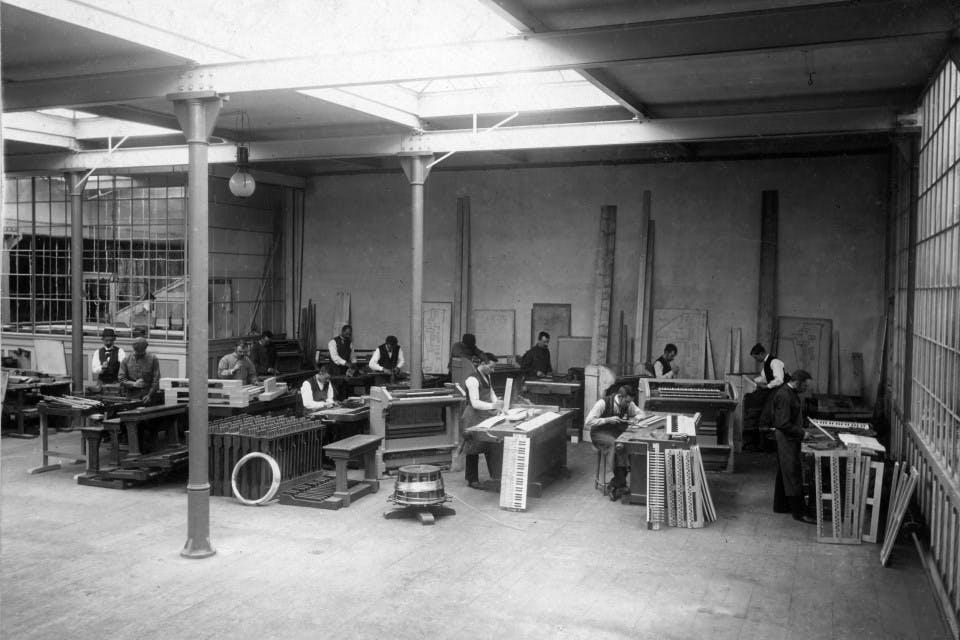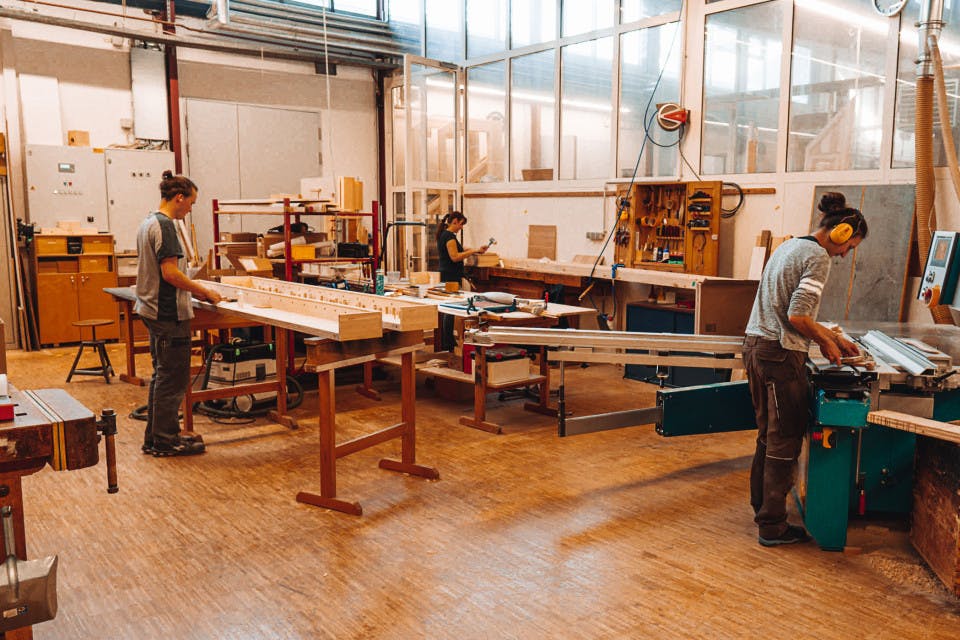BEGINNING OF THE RIEGER STORY
Franz Rieger (1812–1885), who came from a small farming family, completed an apprenticeship as a carpenter in Vienna and trained as an organ builder with Joseph Seyberth before founding his own workshop in his hometown of Jägerndorf in Silesia (now Krnov), thereby laying the foundation for the organ building firm, "Rieger Orgelbau", a company that operates worldwide today.
The first instruments, mechanical slider chest organs with up to 20 stops, were made in modest workshops.
Of the founder's children, Otto Anton (1847-1903) and Gustav Rieger (1848-1919) chose to follow their father's trade. After an apprenticeship in their father's company, their journeyman years took them to the most important organ builders of that time in Germany.

Company founder Franz Rieger (1812-1885)
SECOND GENERATION: RIEGER BROTHERS
The world exhibitions in Vienna in 1873 and in Paris in 1878 were decisive turning points in the company's history. Franz Rieger's sons joined their father's business and began to put the traditional business processes on a new footing, from 1880 as sole owners under the name "Gebrüder Rieger".
Due to the numerous follow-up orders after the world exhibitions, a large new workshop building was required, which could accommodate all the technical developments of that time.
Photos: Otto and Gustav Rieger / Otto Rieger as mayor / Assembly hall


ORGANS WITH MECHANICAL CONE WINDCHESTS
The Rieger brothers organised their firm according to industrial concepts, i.e. they aimed rationally to achieve the highest possible production, whilst artistically maintaining high quality. Their sensitive mechanical cone chest organs met with widespread approval in professional circles, with the result that the first exports to Scandinavia and especially to Southeast Europe soon followed. The founding of a branch in Budapest in 1894 was the logical consequence.
Company housing was built for the rapidly growing workforce and a company health insurance fund was set up. Incentivised by these social benefits, the employees were encouraged to perform at their best and were thereby effectively tied to the company in the long term.





By 1900, the company premises had grown to 20,000 m² and around 150 employees worked in the newly built workshops.


SUCCESSFUL CONSTRUCTION OF LARGE CONCERT HALL ORGANS
In 1902 the brothers separated, and Gustav retired to Vienna. Otto Franz Rieger (1880-1920) - of the third generation - ran the business alone from 1903.
The company was now so efficient that up to 90 instruments could be delivered per year. The basis for this was a sophisticated construction system that enabled cost-effective production, despite the instruments’ meeting all quality requirements. At the same time there was a breakthrough in the construction of large concert hall organs.

Otto Franz Rieger (1880-1920)


SUCCESSOR, JOSEF VON GLATTER-GÖTZ
The First World War and the end of the Austro-Hungarian Monarchy severely affected the course of business; so also did the unexpected death of the company owner in 1920. His widow was unable to cope with the economic problems of the interwar period, but found a suitable successor in the retired Lieutenant Colonel, Joseph von Glatter-Götz (1880–1948), who was able to take over the business in 1924.
However, in the national states of Central Europe that emerged after 1918, the old markets had to be recaptured. During these years, Josef Kloss acted as workshop manager before becoming self-employed in 1937.

Josef von Glatter-Götz (1880-1948)
THE NEXT GLATTER-GÖTZ GENERATION
From 1936, the next generation of the Glatter-Götz family joined the company. Egon (1911–1940) and Joseph Glatter-Götz Jr. (1914–1989) undertook technical and academic studies in Breslau and Berlin to supplement their training in their own company.
At this time, in addition to pneumatic actions, electrical systems were often built, and the tonal requirements of the Romantic organ were adapted to suit customer requirements in favour of classical ideas.
With the establishment of further branches in Scandinavia, Poland and Austria, new markets were opened up, overseas exports intensified, and in 1926 another fully-fledged organ building site was built near the parent company in German-Polish Mocker.
Austria’s political merger with the German Reich initially brought a further upswing, but organ building came to a standstill as early as 1942 due to the war.
By then, the opus numbers had long since exceeded 3000, and with up to 200 employees, Rieger was one of the largest organ building companies of the time.

Egon und Josef Glatter-Götz



END OF THE WAR AND A NEW BEGINNING
The end of the war in 1945 brought a temporary end to the firm. As a victim of the Benes decrees, the Glatter-Götz family was expropriated and had to leave the Czech state without compensation, together with the German-speaking workforce.
The branch in nearby Mocker was destroyed in 1945, and the remaining subsidiaries also came to an end. After its destruction, the plant in Budapest was reconstructed and continued as the Aquincum company (without any connection to Rieger), and the parent company in Jägerndorf was placed under national administration. From 1947, when Josef Kloss was appointed the new company manager, the workshops were transformed into the Rieger-Kloss company. Privatized from 1989, operations were finally shut down in 2015.
In 1946, the Glatter-Götz family managed to start anew in very modest circumstances in the abandoned workshops of the Behmann company (1878–1931) in Schwarzach, Vorarlberg.

Neubeginn in bescheidenen räumlichen Verhältnissen

EXPORT SUCCESS AROUND THE WORLD
Joseph Glatter-Götz (Junior) had already started designing and building small mechanical slider chest organs in 1936, which could now form the intellectual foundation for further development.
However, it was only participation in the 1949 trade fair in Dornbirn/Vorarlberg that brought the decisive breakthrough. Famous musicians like Hindemith and Karajan now became aware of Rieger. The first exports to the USA were achieved with instruments ranging from four to 21 registers. This success was followed by Germany, later Switzerland and finally Austria. The share of exports overseas rose continuously as a result.
Joseph Glatter-Götz (Junior) enriched post-war organ building not only through significant technical improvements (actions, combination systems, pallets, double stop-actions in 1965, electronic combination systems in 1968). He was also one of the few organ builders of this time who consistently found stylistically meaningful solutions for organ case designs.

Barfüßerkirche Augsburg 1958 (36/III)

NEW WORKSHOP CONSTRUCTION
The extremely simple workshops, scattered throughout the village of Schwarzach, were finally combined into a spacious new workshop building in 1972. After an extensive restructuring of the company in 1993, the building housing the company headquarters was repeatedly expanded and the equipment improved in the following years.

New building in 1972
SIXTH GENERATION AND IMPROVED ORGAN ACTIONS
As early as 1969, the next generation, Caspar Glatter-Götz (* 1945), joined the company (as operations manager), with his brothers, Raimund (1948–2013) and Christoph (* 1951), following in 1977. In 1984, they finally took over the company: Caspar headed the workshop, Raimund carried out the artistic work (facade design), Christoph took over the commercial side.
In 1972, the mechanisms of organ actions were optimised in the newly built company building through comprehensive and intensive tests. The cathedral organ in Ratzeburg near Lübeck (1978, IV/60) was a first highlight and brought many follow-up orders for the construction of large instruments worldwide.
In 1993, Caspar Glatter-Götz left the company in Schwarzach for personal reasons to start his own company in southern Germany.

The brothers Caspar, Raimund and Christoph Glatter-Götz
WITH NEW IMPULSES INTO THE FUTURE
Ten years later, in 2003, there was a generational change at Rieger Orgelbau in Schwarzach. Wendelin Eberle (* 1963), who had been with the company since 1978, took over the overall responsibility with 38 employees at that time. In the meantime, the workforce has grown to over 60 people from all over the world. One reason for this increase in personnel is the endeavour to produce as many details of an organ as possible in-house, as well as the permanent establishment of an in-house restoration department.
Due to a clearly changed prioritisation of sound and stylistic characteristics as well as technical novelties that benefit the immediate artistic practice (proportional action and stop action, quarter-tone piano, adjustable wind pressure, etc.), organ building as a whole received innovative impulses from Wendelin Eberle and his competent team, which can be seen in numerous outstanding instruments of the last twenty years - representative of all - especially in renowned concert hall instruments or cathedral organs.

Wendelin Eberle, owner and CEO since 2003






